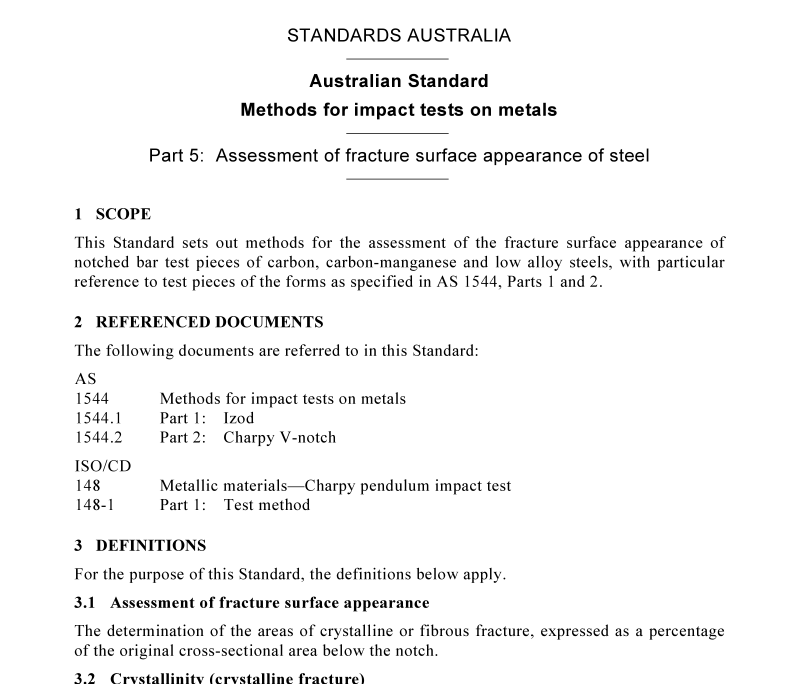AS 1544.5 pdf download – Methods for impact tests on metals Part 5: Assessment of fracture surface appearance of steel

AS 1544.5 pdf download – Methods for impact tests on metals Part 5: Assessment of fracture surface appearance of steel
4METHODS FOR DETERMINATION OF PERCENTAGE CRYSTALLINITY AND
FIBROSITY
4.1 Methods and accuracy4.1.1 General
The fracture surface of the Charpy and Izod test pieces is often rated by the percentage ofshear fracture that has occurred.The greater the percentage of shear fracture, the greater thenotch toughness of the material. Because the rating is extremely subjective,it isrecommended that it be not used in specification.
NOTE: The term “fibrous-fracture appearance’ is ofien used as a synonym for shear-fractureappearance.The terms,’cleavage-fracture appearance’and ‘crystallintiy’are often used toexpress the opposite of shear fracturer. That is, zero percent shear fracture is 100 percentcleavage fracturc.
4.1.2 Methods
As crystalline and fibrous areas of a fracture surface of the broken test piece canbe distinguished visually by their appearance when viewed from several angles under apoint source of light or under parallel light, the percentage of each type of fracture surfacepresent may be dctermined by—
(a)direct visual estimation;
(b)direct measurement without magnification; or(c)measurement with magnification.
NOTE: Methods (a) and (b) may not be suitable where there are several areas of crystallinity,as may occur in weld metal.
4.1.3 Accuracy
An accuracy of 土10 percent crystallinity or fibrosity can be achieved with methods( a) and (b) and 15 percent with method (c).
4.Procedure for direct visual estimation.The procedure shall be as follows:
(a) Examine the fracture surface under a point source of light or under parallel light.
NOTES:
l An ordinary light bulb is preferable to strip lighting. and a small brilliant bulb in areflector provides the best practical contrast. Direct natural light is also satisfactory.
2 ln some metals,such as fine-grained alloy steels, the facets in the crystalline fracture face
are very small with the result that the area appears dull and only of slightly lighter greycolour than the fibrous area.
ln these circumstances,the area of crystallinity can best be distinguished by its densegranular texture compared with the spongy or silky texture of the fibrous area,
(b) Estimate the percentage crystallinity and percentage fibrosity by one of the following
means:
iCompare the surface with fracture appearance charts as shown in Figure 1.(i) Use prepared macrographs and Figure 2.
(iii) Compare with a reference set of control pieces for which the percentage
crystallinity and percentage fibrosity have previously been accuratelydetermined.
(c)Record the result.
4.3Procedure for direct measurement without magnificationThe procedure shall be as follows:
(aView the fracture surface without magnification and measure the apparent mean
dimension A and B (see Figure 2) of the crystalline area by means of a scalegraduated in millimetres, or a card having an opening graduated in millimetres.
(b)
Calculate the percentage crystallinity or percentage fibrosity by use of the equationscontained in Clause 5, or read the result directly from a table appropriate to the testpiece dimensions.
Tables 1 to 7 have been prepared for Izod and Charpy V-notch test pieces.
NOTE:Table 7 has been included for 10 mm x 6.7 mm test pieces because of increasing useof this size.
4.4Procedure for measurement with magnificationThe procedure shall be as follows:
(a)Use a measuring microscope, optical projector or projection microscope at low power
magnification to view the fracture surface and determine the areas of crystallinity byone of the following means:
(i The use of a planimeter on a tracing or projected image.
(ii)Counting squares on a grid on a tracing, projection screen or graticule eyepiece.(iii) The linear measurement of dimensions A and B (see Figure 2).
(b)
Calculate the percentage crystallinity or percentage fibrosity by use of the equationscontained in Clause 5 or read the result directly from a table appropriate to the testpiece dimensions (see Tables 1 to 7).
(c)Where there are several areas of crystallinity,as may occur in weld metal,use the
aggregate area to calculate the percentage area.
5 CALCULATION OF RESULTS
Calculate the results by use of the following equations, as appropriate:









